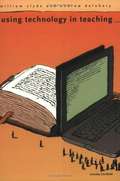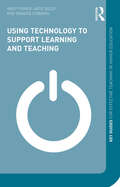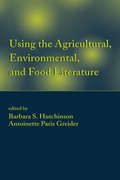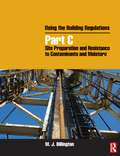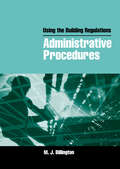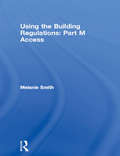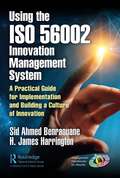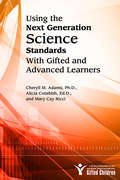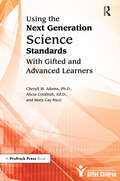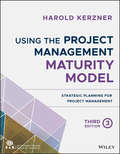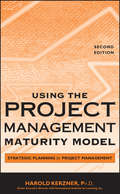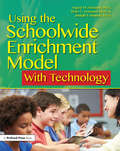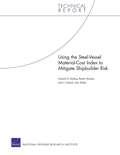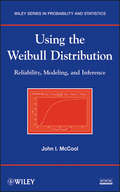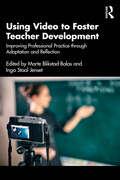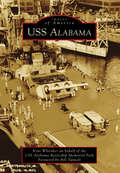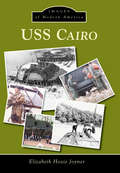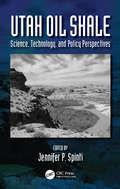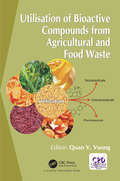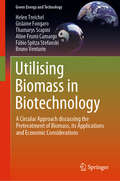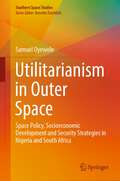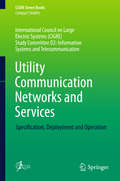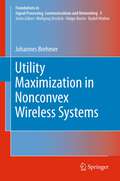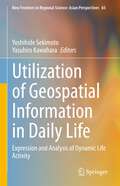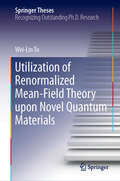- Table View
- List View
Using Technology in Teaching
by William Clyde Andrew DeloheryComputers can help teachers accomplish many of their tasks more efficiently and effectively, but how can a time-strapped teacher determine which pieces of technology are likely to be most helpful? This easy-to-read book offers useful guidance for real-world situations. Organized around specific instructional goals (improving student writing, promoting collaborative learning) and commonly encountered tasks (communicating with students between class, distributing course materials), the book shows teachers at all instructional levels when and how technology can help them meet everyday challenges. Written in an anecdotal, non-technical style, the book and its accompanying CD-ROM cover how to use technology to: communicate with students distribute course materials promote collaborative learning learn through experience clarify course objectives improve student writing develop student research skills use assessment and feedback collect course materials identify plagiarism and more Teachers looking for tools to help them work better and more quickly will welcome this invaluable guide to the technology that will expedite their search.
Using Technology to Support Learning and Teaching: A Practical Approach (Key Guides for Effective Teaching in Higher Education)
by Kate Exley Andy Fisher Dragos CiobanuThe climate of Higher Education is changing rapidly. The students are more likely to see themselves as consumers and have increasingly high expectations regarding teaching and learning. Universities are in part aiming to meet this need by increasing the use of technology; for example, whether to increase access to teaching materials outside the classroom or to make lectures more interactive. Although there is no illusion amongst Higher Education intuitions that technology is a panacea, it is clear that technology is a vital tool in meeting expectations and one that will be used more and more. Consequently the context of this book is one in which technology needs to be understood as part of an overall teaching practice. Technology continues to move on a pace and is used increasingly within Higher Education to support and enhance teaching and learning. There are books which are steeped in technical detail and books which are steeped in theoretical pedagogy with little discussion about the impact on learning and student/teacher behaviour. Using Technology to Support Learning and Teaching fills a gap in the market by providing a jargon free (but pedagogically informed) set of guidance for teaching practitioners who wish to consider a variety of ways in which technology can enrich their practice and the learning of their students. It integrates a wide range of example cases from different kinds of HE institutions and different academic disciplines, illustrating practicable pedagogies to a wide range of readers. It is full of advice, hints and tips for practitioners wanting to use technology to support a style of teaching and learning that is also built on sound pedagogical principles. It will provide a quick user-friendly reference for practitioners wanting to incorporate technology into Higher Education in a way that adheres to their learning principles and values . This book is primarily for teaching practitioners, particularly those who are new to the industry.This book would also prove useful on training courses for practitioners; such as the Postgraduate Certificate for Higher Education. The authors also intend that the book be of value to newer teachers (perhaps taking teacher training programmes) who wish to see where recommended approaches link to pedagogy.
Using the Agricultural, Environmental, and Food Literature (Books In Library And Information Science #Vol. 61)
by Barbara S. Hutchinson Antoinette Paris GreiderThis reference provides the groundwork, tools, and terminology required when conducting specialized searches for information and resources pertaining to traditional and emerging fields of agriculture. The editors present 16 contributions from librarians and other information workers that offer information on research resources across the academic a
Using the Building Regulations
by Mike BillingtonAs the Building Regulations and Approved Documents have become more and more complex, they have become increasingly unfriendly for a professional user. Compliance is only possible by understanding a wide range of supporting documentation. Alternative approaches are implied, but not described or analysed.This book examines Approved Document C on Site Preparation and takes the user through all the key stages of preparation, compliance, inspection and enforcement. It offers practical advice on using not just the traditional routes to compliance but also on the alternative approaches suggested but not explained in the Approved Documents. The advantages and disadvantages of each form of compliance are analysed in depth.Everything you need to know to prepare a site's fixtures against contamination and moisture is discussed, including floors, walls, window frames, door tresholds, and roofs. This is an indispensable text for professional designers, architects, structural and other specialist engineers, building control officers and students in construction, building and architecture.
Using the Building Regulations: Administrative Procedures
by Mike BillingtonAs the Building Regulations and Approved Documents have become more and more complex, they have become increasingly unfriendly for a professional user. Compliance is only possible by understanding a wide range of supporting documentation. Alternative approaches are implied, but not described or analysed.This series of books on individual Documents goes far beyond analysis of the Regulations and Documents themselves, and offers practical advice on using not just the traditional routes to compliance but also on the alternative approaches suggested but not explained in the Approved Documents. The advantages and disadvantages of each form of compliance are analysed in depth.This book examines the background to the Building Regulations, and their evolution to the complex documents of today. Inspection, enforcement and compliance are described in detail.
Using the Building Regulations: Part M Access
by Melanie SmithThis informative book takes the practitioner through the requirements for Part M of the Building Regulations, explaining and expanding the guidance given in the Approved Document, and comparing the advice in BS83000 and other relevant publications. Access statements are demystified, and the implications for the building in use under the Disability Discrimination Act are clarified. It will inform all those working within the built environment, enabling them to deal with a complex and evolving area of the law which directly affects everyone.As with the other books in the Using the Building Regulations series Part M Access goes far beyond analysis of the Regulations and Documents themselves, and offers practical advice on using not just the traditional routes to compliance but also on the alternative approaches suggested but not explained in the Approved Documents. The advantages and disadvantages of each form of compliance are analysed in depth.
Using the ISO 56002 Innovation Management System: A Practical Guide for Implementation and Building a Culture of Innovation (Management Handbooks for Results)
by Sid Ahmed Benraouane H. James HarringtonIn 2019, ISO Technical Committee 279 released a new international standard on innovation management system called ISO 56002:2019. The objective of this standard is to provide a framework on how to build an innovation ecosystem that can be sustained over time. Similar to the quality management system that ISO established decades ago, this standard provides instructions related to best practices on how to manage innovation activities, projects, and programs. It does not describe detailed activities within the organization, but rather provides guidance at a general level. It does not prescribe any requirements or specific tools or methods for innovation activities. Essentially, the standard does not provide guidance on how to implement and/or use the standard. The standard basically tells you what to do and document – this powerful book tells you how to do it. The techniques in this book are directed at key tasks across the innovative process, such as maximizing quality, productivity, maintainability, usability, and reliability, while focusing on reducing the product cycle time and costs within the innovative process. Currently, there are no other comprehensive books available on how to fully implement this standard in companies. This book is crucial for managers, business leaders, entrepreneurs, and consultants looking for help to reap the benefits of an innovation management system. This book takes you step by step through the process of developing an innovation ecosystem. In addition, it provides frameworks, tools, methodologies, cases, and best practices so your organization can experience the full value of the standard.
Using the Next Generation Science Standards With Gifted and Advanced Learners
by Cheryll M. Adams Alicia Cotabish Ed. D. Mary Cay RicciUsing the Next Generation Science Standards With Gifted and Advanced Learners provides teachers and administrators examples and strategies to implement the Next Generation Science Standards (NGSS) with gifted and advanced learners at all stages of development in K?12 schools. The book describes-and demonstrates with specific examples from the NGSS-what effective differentiated activities in science look like for high-ability learners. It shares how educators can provide rigor within the new standards to allow students to demonstrate higher level thinking, reasoning, problem solving, passion, and inventiveness in science. By doing so, students will develop the skills, habits of mind, and attitudes toward learning needed to reach high levels of competency and creative production in science fields.
Using the Next Generation Science Standards With Gifted and Advanced Learners
by Cheryll M. Adams Alicia Cotabish Mary RicciUsing the Next Generation Science Standards With Gifted and Advanced Learners provides teachers and administrators examples and strategies to implement the Next Generation Science Standards (NGSS) with gifted and advanced learners at all stages of development in K-12 schools. The book describes—and demonstrates with specific examples from the NGSS—what effective differentiated activities in science look like for high-ability learners. It shares how educators can provide rigor within the new standards to allow students to demonstrate higher level thinking, reasoning, problem solving, passion, and inventiveness in science. By doing so, students will develop the skills, habits of mind, and attitudes toward learning needed to reach high levels of competency and creative production in science fields.
Using the Project Management Maturity Model: Strategic Planning for Project Management
by Harold KerznerThe industry validated Project Management Maturity Model developed by Dr. Harold Kerzner—updated and expanded Using the Project Management Maturity Model offers assessment tools for organizations of all sizes to evaluate their progress in effectively integrating project management along the maturity curve. This Third Edition includes maturity metrics, examples of Project Management Maturity Model (PMMM) reports, a new chapter on the characteristics of effective PMMM, assessment questions that align with the PMBOK® Guide—Sixth Edition, all-new illustrations that define advanced levels of maturity, assessment tools for organizations using traditional PM methods, and detailed guidance for organizations using Agile and Scrum. Using the Project Management Maturity Model: Strategic Planning for Project Management, Third Edition is broken down into three major parts. The first part discusses the principles of strategic planning and how it relates to project management, the definition of project management maturity, and the need for customization. The second part details the Project Management Maturity Model (PMMM), which provides organizations with general guidance on how to perform strategic planning for project management. The third part of the book looks at some relatively new concepts in project management such as how assessments can be made to measure the firm’s growth using PM 2.0 and PM 3.0. Features customizable maturity model assessment tools for organizations of all sizes Includes assessment questions updated to line up with PMBOK® Guide—6th Edition Offers detailed guidance on applying the maturity model for Agile and Scrum Includes PowerPoint decks to aid in teaching the maturity model Using the Project Management Maturity Model: Strategic Planning for Project Management, Third Edition is an ideal book for senior level and middle level corporate managers, project and team managers, engineers, project team members, and business consultants. It also benefits both business and engineering students in courses on advanced project management.
Using the Project Management Maturity Model
by Harold R. KerznerUpdated for today's businesses-a proven model FOR assessment and ongoing improvementUsing the Project Management Maturity Model, Second Edition is the updated edition of Harold Kerzner's renowned book covering his Project Management Maturity Model (PMMM). In this hands-on book, Kerzner offers a unique, industry-validated tool for helping companies of all sizes assess and improve their progress in integrating project management into every part of their organizations.Conveniently organized into two sections, this Second Edition begins with an examination of strategic planning principles and the ways they relate to project management. In the second section, PMMM is introduced with in-depth coverage of the five different levels of development for achieving maturity. Easily adaptable benchmarking instruments for measuring an organization's progress along the maturity curve make this a practical guide for any type of company.Complete with an associated Web site packed with both teaching and learning tools, Using the Project Management Maturity Model, Second Edition helps managers, engineers, project team members, business consultants, and others build a powerful foundation for company improvement and excellence.
Using the Schoolwide Enrichment Model With Technology
by Angela Housand Brian Housand Joseph RenzulliUsing the Schoolwide Enrichment Model With Technology is an extension of a talent development model implemented in more than 2,500 schools across the U.S. and widely used internationally. More than 40 years of research and development have documented the effectiveness of the SEM approach to promoting higher level thinking skills and creative productivity. This solution-oriented book, unlike other books focused on using technology in the classroom, recognizes that digital technologies are changing and evolving at lightning speeds. Our effective skills for using technology transcend time by focusing on how to find and use digital resources and tools rather than listing the resources that already exist. Focusing on the skills that support critical thinking and problem solving, decision making, and communication, the authors seamlessly merge technology to launch students toward independent productivity. This accessible and highly practical guide is rich with examples that will change the way you think about education while providing hands-on “how-to” guidance for creating a culture of excellence and innovation in your school and classroom.
Using the Steel-Vessel Material-Cost Index to Mitigate Shipbuilder Risk
by John Birkler John F. Schank Edward G. Keating Robert MurphyThe more accurately a cost index captures a shipbuilder's risk, the less the Navy should have to pay its shipbuilders. The Navy uses such indexes to correct for significant cost risks outside its shipbuilders' control. A longtime material-cost index in Navy shipbuilding is the steel-vessel index, but it is outdated and volatile. The authors urge the Navy to develop a modern-vessel index that more appropriately represents the materials used today.
Using the Weibull Distribution
by John I. MccoolUnderstand and utilize the latest developments in Weibull inferential methods While the Weibull distribution is widely used in science and engineering, most engineers do not have the necessary statistical training to implement the methodology effectively. Using the Weibull Distribution: Reliability, Modeling, and Inference fills a gap in the current literature on the topic, introducing a self-contained presentation of the probabilistic basis for the methodology while providing powerful techniques for extracting information from data. The author explains the use of the Weibull distribution and its statistical and probabilistic basis, providing a wealth of material that is not available in the current literature. The book begins by outlining the fundamental probability and statistical concepts that serve as a foundation for subsequent topics of coverage, including: * Optimum burn-in, age and block replacement, warranties and renewal theory * Exact inference in Weibull regression * Goodness of fit testing and distinguishing the Weibull from the lognormal * Inference for the Three Parameter Weibull Throughout the book, a wealth of real-world examples showcases the discussed topics and each chapter concludes with a set of exercises, allowing readers to test their understanding of the presented material. In addition, a related website features the author's own software for implementing the discussed analyses along with a set of modules written in Mathcad®, and additional graphical interface software for performing simulations. With its numerous hands-on examples, exercises, and software applications, Using the Weibull Distribution is an excellent book for courses on quality control and reliability engineering at the upper-undergraduate and graduate levels. The book also serves as a valuable reference for engineers, scientists, and business analysts who gather and interpret data that follows the Weibull distribution
Using Video to Foster Teacher Development: Improving Professional Practice through Adaptation and Reflection
by Marte Blikstad-Balas Inga Staal JensetFeaturing an international team of education researchers and practitioners, this edited volume demonstrates various ways in which the use of video recordings can shed light on and improve teaching processes in the classroom environment.Providing a novel and global approach to this burgeoning area of research, chapters highlight how authentic video clips can be used systematically in both teacher education and professional development programs to ensure lifelong professional reflection and growth for teachers. Through detailed insight into research projects where teachers and teacher educators use video to improve practice, the book provides a research-based response to why and how videos can be used to raise instructional quality and discuss key issues in the field.Exploring findings from empirically based research combined with everyday practices, the volume will ultimately serve as a solid and inspiring introduction to the growing body of research on the use of video in teacher learning for educational researchers and educators interested in teaching and teaching practices, as well as practitioners in the fields of teacher education and teachers’ professional development.
USS Alabama (Images of America)
by Kent Whitaker USS Alabama Battleship Memorial Park Bill TunnellPowerful: this single word aptly describes a naval vessel known as a battleship. The USS Alabama (BB-60) was the last of four South Dakota-class battleships built for World War II. She is well armored and designed to survive an attack while continuing to fight. Her main battery, known as "Big Guns," consisted of nine 16-inch guns; each could launch a projectile weighing as much as a small car that could hit a target 21 miles away. Her crew numbered 2,332 men, none of whom were lost to enemy fire, earning her the nickname "Lucky A." She served as more than just a battleship: she carried troops, supplies, and seaplanes and served in the Pacific and Atlantic; her doctors treated patients from other ships; she was the wartime home for a major-league ballplayer; the movie setting for Hollywood films; and she traveled home to the state of Alabama with the help of schoolchildren.
USS Cairo: History And Artifacts Of A Civil War Gunboat (Images of Modern America)
by Elizabeth Hoxie JoynerArmed with a simple pocket compass, a small boat, and an intense desire to find the USS Cairo, three men--Edwin C. Bearss, Warren Grabau, and Max Don Jacks--set out on the Yazoo River on a cool autumn afternoon in 1956 to locate the Civil War gunboat. What they found was the discovery of a lifetime. Images of Modern America: USS Cairo features a photographic account of the discovery, raising, restoration, and preservation efforts surrounding the Cairo. One can sense the excitement and awe felt by people who witnessed the raising. Today, people from all over the world are drawn to visit this Civil War time capsule now in permanent dry dock at Vicksburg National Military Park, where commemorative events have occurred since 1980; this collection highlights a variety of these events.
Utah Oil Shale: Science, Technology, and Policy Perspectives
by Jennifer P. SpintiIncludes full-color isopach and richness maps for each organic-rich and organic-lean oil shale interval within the upper Green River Formation. Offers computational exploration of trade-offs in drilling and heating options on the net energy return for oil produced from an in situ process. Analyzes costs and emissions associated with in situ production of oil shale. Discusses legal and policy issues for a nascent oil shale industry.
Utilisation of Bioactive Compounds from Agricultural and Food Production Waste
by Quan V. VuongThe large quantity of waste generated from agricultural and food production remains a great challenge and an opportunity for the food industry. As there are numerous risks associated with waste for humans, animals and the environment, billions of dollars are spent on the treatment of agricultural and food waste. Therefore, the utilisation of bioactive compounds isolated from waste not only could reduce the risks and the costs for treatment of waste, but also could potentially add more value for agricultural and food production. This book provides comprehensive information related to extraction and isolation of bioactive compounds from agricultural and food production waste for utilisation in the food, cosmetic and pharmaceutical industries. The topics range from an overview on challenges and opportunities related to agricultural and food waste, the bioactive compounds in the waste, the techniques used to analyse, extract and isolate these compounds to several specific examples for potential utilisation of waste from agricultural and food industry. This book also further discusses the potential of bioactives isolated from agricultural and food waste being re-utilised in the food, cosmetic and pharmaceutical industries. It is intended for students, academics, researchers and professionals who are interested in or associated with agricultural and food waste.
Utilising Biomass in Biotechnology: A Circular Approach discussing the Pretreatment of Biomass, its Applications and Economic Considerations (Green Energy and Technology)
by Aline Frumi Camargo Fábio Spitza Stefanski Helen Treichel Gislaine Fongaro Thamarys Scapini Bruno VenturinThis book addresses the developing area of biomass for technological applications. Written by leading researchers in the field, the book differs from other literature available by providing a detailed, in-depth discussion of the characteristics of these materials. The use of biomass for technological applications is a rapidly growing area in materials engineering and green bioprocesses. In this approach, pre-treatments focus on the bioavailability of nutrients and facilitate the use of biomass for delivering byproducts (e.g. enzymes) and for bioenergy production, both of which are discussed at length in this book. In this regard, it explores various aspects of the structural complexity of residual biomass produced by agricultural, industrial and livestock activities for biotechnological purposes, and assesses both conventional and emerging pre-treatments (e.g. biological, enzymatic and physical–chemical). This book reveals the advantages of these techniques, both individually and in combination, making it an excellent resource for all readers interested in cutting-edge applications of biomass.
Utilitarianism in Outer Space: Space Policy, Socioeconomic Development and Security Strategies in Nigeria and South Africa (Southern Space Studies)
by Samuel OyewoleThis book showcases Nigerian and South African experiences on space politics, policy and strategy vis-à-vis their development and security aspirations, while contributing to the broader African and the Global-South perspectives on the subject. Space policy in developing countries such as Nigeria and South Africa is motivated by utilitarian promises that space and the attendant technologies have the potential to advance development and security interests of the affected nations. However, several decades into the orbital journey of these countries, little is known of their space politics, policies, strategies, capacities and capabilities, and realisation of desired objectives. Beyond pure and applied sciences reductionism, this book offers social science perspectives on space studies in Africa, as it examines the intricate relationships of historical, geographical, social, demographic, economic, political, administrative, and strategic factors, nationally, regionally and globally that have shaped research and development of space science and technologies, and their benefits, in Nigeria and South Africa.
Utility Communication Networks and Services
by Carlos SamitierThis CIGRE green book begins by addressing the specification and provision of communication services in the context of operational applications for electrical power utilities, before subsequently providing guidelines on the deployment or transformation of networks to deliver these specific communication services. Lastly, it demonstrates how these networks and their services can be monitored, operated, and maintained to ensure that the requisite high level of service quality is consistently achieved.
Utility Maximization in Nonconvex Wireless Systems
by Johannes BrehmerThis monograph develops a framework for modeling and solving utility maximization problems in nonconvex wireless systems. The first part develops a model for utility optimization in wireless systems. The model is general enough to encompass a wide array of system configurations and performance objectives. Based on the general model, a set of methods for solving utility maximization problems is developed in the second part of the book. The development is based on a careful examination of the properties that are required for the application of each method. This part focuses on problems whose initial formulation does not allow for a solution by standard methods and discusses alternative approaches. The last part presents two case studies to demonstrate the application of the proposed framework. In both cases, utility maximization in multi-antenna broadcast channels is investigated.
Utilization of Geospatial Information in Daily Life: Expression and Analysis of Dynamic Life Activity (New Frontiers in Regional Science: Asian Perspectives #65)
by Yoshihide Sekimoto Yasuhiro KawaharaThis book focuses on geospatial information in living spaces, providing many examples of its collection and use as well as discussing the problems of how it is used and its future prospects.Geospatial information science is in the process of evolving and being systematized, with the technical and usage aspects of the real world stimulating each other. This book systematizes the technical aspects of positioning; of geography, which manages and represents what is measured in units of earth coordinates; and of data science, which aims to efficiently express and process geographic information, all by introducing contemporary examples that are systematized with regard to their use in our living spaces. Examples of geospatial information used in almost all aspects of our lives, including urban areas, transportation, disaster prevention, health and medical care, agriculture, forestry and fisheries, culture, ecology, and topography, are presented, along with examples of their use in each area. One of the major features of this book is that it describes the use of data from earthquake disasters that is unique to Japan, as well as the use of open data and personal data in Japan, which is a trend that is gaining attention in many countries. In this way the book systematically describes events and circumstances in living spaces that are revealed by the expression and analysis of geospatial data, with case studies and discusses their use in the IoT era.
Utilization of Renormalized Mean-Field Theory upon Novel Quantum Materials (Springer Theses)
by Wei-Lin TuThis book offers a new approach to the long-standing problem of high-Tc copper-oxide superconductors. It has been demonstrated that starting from a strongly correlated Hamiltonian, even within the mean-field regime, the “competing orders” revealed by experiments can be achieved using numerical calculations. In the introduction, readers will find a brief review of the high-Tc problem and the unique challenges it poses, as well as a comparatively simple numerical approach, the renormalized mean-field theory (RMFT), which provides rich results detailed in the following chapters. With an additional phase picked up by the original Hamiltonian, some behaviors of interactive fermions under an external magnetic field, which have since been experimentally observed using cold atom techniques, are also highlighted.
